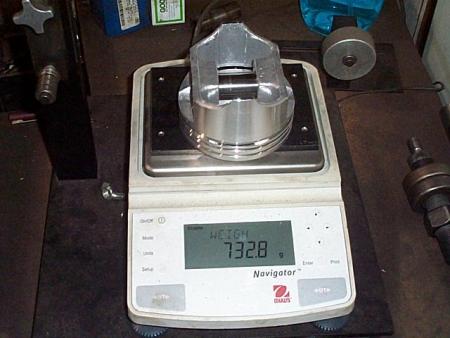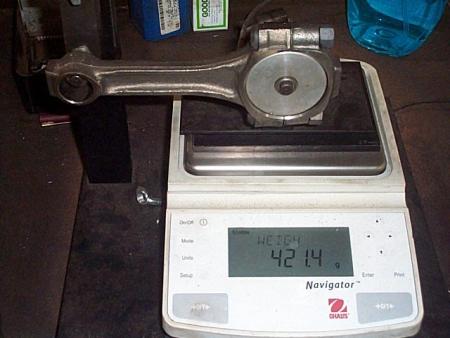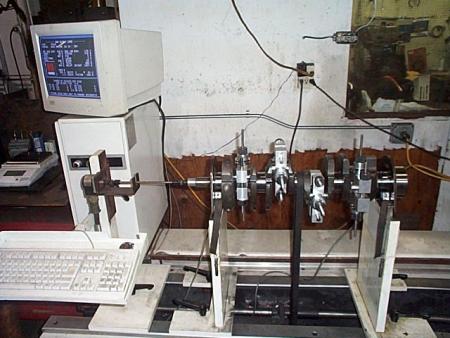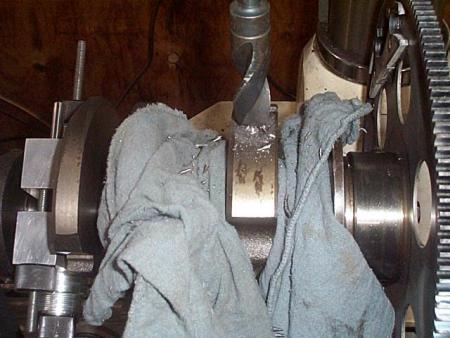
Engine Balancing By Eddies Performance
Engine balancing is a standard procedure utilized at Eddies Performance machine shop. In fact we feel engine balancing is one of the most important aspects of building your engine right because balancing rotating assemblies affects every aspect of your engine running right. Balancing goes hand-in-hand with performance engine building. Balancing reduces internal loads and vibrations that stress metal and may eventually lead to component failure.
From a technical point of view, every engine regardless of the application or its selling price can benefit from balancing. A smoother-running engine is also a more powerful engine. Less energy is wasted by the crank as it thrashes about in its bearings, which translates into a little more usable power at the flywheel. Reducing engine vibration also reduces stress on motor mounts and external accessories, and in big over-the-road trucks, the noise and vibration the driver has to endure mile after mile.
Though all engines are balanced from the factory (some to a better degree than others), the original balance is lost when the pistons, connecting rods or crankshaft are replaced or interchanged with those from other engines. The factory balance job is based on the reciprocating weight of the new pistons and rods. If any replacements or substitutions are made, there’s no guarantee the new or reconditioned parts will match the weights of the original parts closely enough to retain the original balance. This is why Eddies goes to every length to make sure your engine is balanced properly.
Most aftermarket replacement parts are "balanced" to the average weight of the OEM parts, which may or may not be close enough to maintain a reasonable degree of balance inside the engine. Aftermarket crank kits are even worse and can vary considerably because of variations within engine families.
Balancing is even more important when you’re building a performance motor, a stroker motor or an engine that’s expected to turn a lot of rpms or run a lot of miles, so balancing is an absolute must. No engine is going to survive long at high rpms if it’s out of balance. And no engine is going to last in a high mileage application if the crank is bending and flexing because of static or dynamic imbalances.
How Eddies Performs The Engine Balancing Process
The process of balancing begins by equalizing the reciprocating mass in each of the engine’s cylinders. This is done by weighing each piston on a sensitive digital scale to determine the lightest one in a set. The other pistons are then lightened to match that weight by milling or grinding metal off a non-stressed area such as the wrist pin boss. The degree of precision to which the pistons are balanced will vary from one engine builder to another, and depends to some extent on the application. But generally speaking pistons are balanced to within plus or minus 0.5 grams of one another.

Next the rods are weighed, but only one end at a time. A special support is used so that the big ends of all the rods can be weighed and compared, then the little ends. As with the pistons, weights are equalized by grinding away metal to within 0.5 grams. It’s important to note that the direction of grinding is important. Rods should always be ground in a direction perpendicular to the crankshaft and wrist pin, never parallel. If the grinding scratches are parallel to the crank, they may concentrate stress causing hairline cracks to form.

On V6 and V8 engines, the 60 or 90 degree angle between the cylinder banks requires the use of "bobweights" on the rod journals to simulate the reciprocating mass of the piston and rod assemblies. Inline four and six cylinder crankshafts do not require bobweights. To determine the correct weight for the bobweights, the full weight of a pair of rod bearings and the big end of the connecting rod, plus half the weight of the little end of the rod, piston, rings, wrist pin (and locks if full floating) plus a little oil are added together (100 percent of the rotating weight plus 50 percent of the reciprocating weight). The correct bobweights are then assembled and mounted on the crankshaft rod journals.
The crankshaft is then placed on the balancer and spun to determine the points where metal needs to be added or removed. The balancer indexes the crank and shows the exact position and weight to be added or subtracted. The electronic brain inside the balancer head does the calculations and displays the results.

If the crank is heavy, metal is removed by drilling or grinding the counterweights. Drilling is usually the preferred means of lightening counterweights, and a balancer that allows the crank to be drilled while still on the machine can be a real time saver.
If the crank is too light, which is usually the case on engines with stroker cranks or those that are being converted from externally balanced to internally balanced, heavy metal (a tungsten alloy that is 1.5 times as heavy as lead) is added to the counterweights. This is usually done by drilling the counterweights, then press fitting and welding the heavy metal plugs in place.

After drilling, the crankshaft is again spun on the balancer to determine if additional corrections are required. If the crank is for an externally balanced engine (such as a big block Chevy), the balancing will be done with the flywheel and damper installed. On internally balanced engines, the flywheel and damper can be balanced separately, or installed on the crank and balanced as an assembly once the crank itself has been balanced. Eddies Performance machinery has been simplifies the balancing process and increases the accuracy of our job. Our electronic equipment allows accurate measurement of not only the amount of unbalance force, but also accurately reports the unbalanced vector position.
Get The Balance Perfectly Right!
A typical Chevy smallblock V8 might take anywhere from 45 minutes to an hour-and-a-half depending on how much work is needed. Sometimes we have spent anywheres from 3-5 hours on engines that are way out of balance. Balancing accuracy of plus or minus one gram is typically good enough for most production street engines and our balancers can achieve balancing accuracies in the hundredths of a gram!
The most time-consuming part of the job is weighing and matching the pistons and rods. A four cylinder engine takes half as much time for this step as a V8. The next most time consuming part is making up the bobweights for a V6 or V8. This step isn’t needed with a straight six or four. The actual setup on the machine takes only a few minutes, and the initial spin and readings take only a couple of minutes more. The time required to perform the necessary weight corrections will depend on the crank (weight removal goes much faster than adding weight).
The complete engine balancing process we go through at Eddies Performance must be performed as painstakingly and accurately as possible. The balanced engine is the utmost in performance, horsepower and durability possible, and its success is a real testimony to the expertise of the years of experience at Eddies Performance.
Quality Control With Your Engine Is Our #1 Priority
At Eddies Performance quality control is an important factor in our customer experience. Careful measures in checking and double checking clearances is our precedence in producing a fast, reliable engine that will bear our responsibility.
If you would like to discuss your application please give us a call on our toll free number 1-800-471-2325 from 9am to 5pm EST.
|





